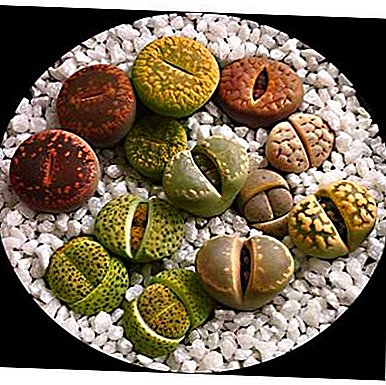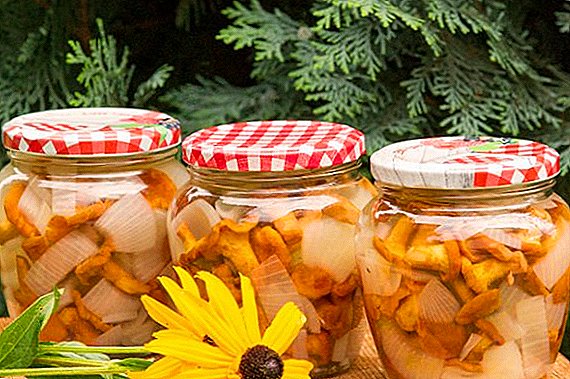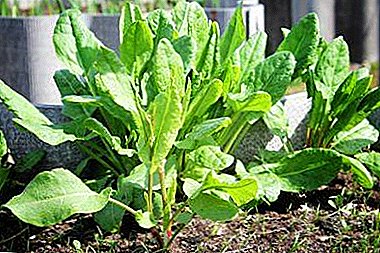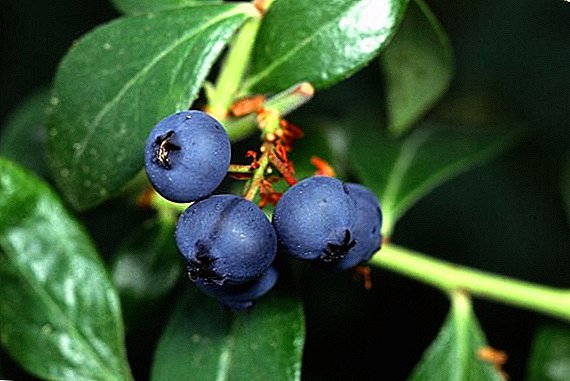
Lithops are called living stones, not only for their resemblance to pebbles, but also for their slow growth.
This feature can be profitably used to create mini-landscape compositions that are very fashionable today: the panorama will be preserved in its original form for a very long time.
It is enough to provide the “pebbles” with the right ground, to have a window on the sunny side of the house and not to grab the watering can more often than once every two weeks.
In the article you will find all about types of Lithops with photos, learn how to care for them at home.
Kinds
Optics
Lithops Optics (Lithops Optica). It differs from other species of Lithops by the lilac-purple color of the leaves. Their inner surface is somewhat lighter than the rest of the color of the plant.
White long petals flower buds rounded from the outside and a series of light yellow stamens, are placed deeply “in the crack” between the leaves.
The maximum normal height of an adult plant is 2 cm.

Olive Green
Lithops Olive Green (Lithops Olivaceae). Like most Lithops, they have the shape of a heart with truncated tops on both halves.
Grayish with a green tint, on the flat upper areas intensively gray with white chaotically located interspersed. Peduncles light green, flower buds pale yellow.

Marble
Lithops Marmorata. The upper part of the grayish-white or greenish-gray plant surface is dotted with numerous broken lines of rich gray color, forming a "marble" pattern.
In appearance, the plant skin has a velvety surface. Flowers are white with a yellow middle, about 5 cm in diameter.

Leslie
Lithops Leslie (Lithops Lesliei). Representatives of the species with strongly shortened back-cone-shaped, fleshy leaves of gray, gray-blue color.
The "crack" between the leaves, typical of Lithops, is shallow, most often arched.
The flat part of the truncated leaves has a mesh pattern of numerous small broken lines, diverging from several large "trunks" or a dark spot that occupies most of the top.

Brownish
Lithops Fulviceps. Brown-brown or coffee-brown plants in which the upper flat part of the leaves is dotted with irregular-shaped spots.
Between them, the color of the peel is more intense color, so it seems that on the leaves squeezed dark mesh. The extreme ends of the lines forming the mesh pattern are rusty brown.
The flowers are rich yellow with a touch of lemon. In the center of the opened bud a column is formed from numerous stamens of the same color, tightly pressed to each other. The diameter of the open flower can reach 3 cm.

Aukamp
Lithops Aukampiae. Often found in the collections of flower growers Lithops with densely accrete leaves. A typical “crack” for this kind of color, dividing the plant into two unequal parts, small and short.
The tops of the leaves have a pattern of randomly arranged small thick lines of irregular shape and spots of different sizes. "Crack" of the same color as the bottom, the sides of the leaves, with a good view of the border on the outer edge.

Captured
Lithops pin-shaped (Lithops turbiniformis). The brick-coffee shade and the shape of the spread leaves, typical for Lithops, makes them similar to slightly roasted coffee grains.
The truncated tops are covered with a mesh of broken lines and dark brown spots. The surface of the leaves is rough. The color of the opened buds is orange-yellow.
The flowering period of the entire summer and autumn season.

Nice
Lithops beautiful (Lithops bella). Between olive-gray or olive-ocher leaves, a fault typical of this plant species can be seen, reaching almost to the ground level.
Drawing on the horizontal plane of the leaf is dark olive, formed by thick broken lines. The beautiful adult Lithops grows 2.5 to 3 cm above the ground, and quickly acquires its neighbors children.
The period of formation and opening of the buds is September. The flowers are white, with a pleasant distinct aroma..

Divided
Lithops divided (Lithops divergens). The greenish-gray leaves in the upper horizontal part are covered with a pattern of small merging spots of a more saturated color than the color of the rest of the plant.
Unlike many other types of Lithops, Lithops divergens is not like a heart truncated at the top or huge coffee beans, but a cylinder or a claw divided into two parts. Blooms yellow.

Soleros
Lithops Soleros (Lithops salicola). Outwardly, this type of lithops resembles a slingshot stuck in the ground: the olive-gray leaves of the plant have a cylinder-like shape.
Their upper side is dark green, with a bright border around the concave middle of a dark gray color. When flowering, it throws out one white flower, similar to the flowers of non-cultivated chrysanthemum.

False shredded
Lithops, false truncated (Lithops pseudotruncatella). From the relatives of other species is characterized by the presence of a very small and narrow rift between a pair of leaves.
Color varied: brownish, pinkish, grayish. Adult bushes can reach 3 cm in height. Drawing on a flat horizontal part of the leaves of the same color as the leaves themselves, but more intense shade.
Bloom It takes place in the first two months of autumn, the color of blossoming buds is golden yellow.

Mix
Lithops mix. Rarely among the gardeners who stop growing on a single instance of Lithops. For one "pebble" will necessarily follow the acquisition of a representative of another species or its seeds.
In order for the already existing "boulder" not to get bored - plants grow better in the company of their own kind or other succulents. And a pot with several "pebbles" looks much more decorative. And when the flowering season begins, the joy of the grower is immense.
More beautiful is the pot in which it is planted. mix of lithops.

 Lithops succulents are very often compared to cacti. Both those and others are desert inhabitants, who are successfully grown at home.
Lithops succulents are very often compared to cacti. Both those and others are desert inhabitants, who are successfully grown at home.On our site you will find a lot of useful information about forest and desert cacti.
Copies of a similar shape, but of different colors, collected in one pot, by themselves look very decorative. Having landed raspberry-purple Optics in the center of the composition, several Bromfield or representatives of the species can be placed around it.
No less cute looks pot with seven or more single instances of different types. Gray, beige, gray-green, yellowish, all with their leaf pattern will delight the eye even during the next season of "hibernation".
If all of them bloom at the same time, then there is no greater reward for a grower keen on growing Lithops.
Several plants of the same type look like a full bush with plump short branches. Collected in a pile, they will not interfere with each other if placed on a windowsill with a sufficient amount of light. Water is enough for them too.
The main thing when watering to avoid moisture in the crevice between the leaves.
Speaking about the care of the Lithops mix at home, it should be noted that it is better to carry out all moistening with a watering can with a thin long nose or to irrigate unpretentious wards with clean and well-settled water from a spray bottle with a finely dispersed spray.
Lithops need not only neighbors in the pot, but also specific ground surface. Be sure to lay it out. more pebbles of different size and colorsprinkle coarse sand and add fine gravel.
Such a "lunar" panorama will help create conditions for plants similar to their natural habitat, which will contribute to the active growth of plants and their health, and protect them from excess moisture on the surface immediately after watering.
 Lithops are a large group of plants called succulents. They have a common ability - to accumulate water.
Lithops are a large group of plants called succulents. They have a common ability - to accumulate water.On our site you will find a lot of useful information about the representatives of succulents. Read all about Jade and Aloe.
Care and cultivation
Choosing a place
Lithops are very fond of light. The best choice for their cultivation - the southern window. When choosing a place, remember that Lithops extremely negatively relate to changing places, having chosen it once, leave the plants there for a long time.
Pot selection
Lithops have a well-developed root system, for a comfortable existence, they need a medium-sized pot. But, this is not the most important thing, and the main thing here is that the Lithops - the plants are “social”, they languish alone. Therefore, it is better to plant them and pick a pot based on this.

The soil
At home, Lithops grow on stony soils, which are equally easy to pass water and air. In room conditions, you should not use light peat soil, it will be better for Lithops if the mixture is present. clay, red brick dust, large river sand and leaf humus. The surface can be covered with stones.
Humidity
In the summer it doesn’t hurt to spray water around the plant.
Temperature
In a room with a moderate temperature of the air plants feel good. In winter, he needs coolness, around 10-12 degrees. In the summer, Lithops can be put up in the open air, they love it.
Watering
Lithops may die from excessive watering. Water it extremely moderately to avoid rotting of the roots. The use of bottom watering is encouraged. Make sure that water does not fall into the gap between the leaves. In the dormant period, the plants do not water. The onset of the dormant period can be determined by cessation of growth and dull leaves.
Top dressing
Usually, Lithops do not need additional feeding. If the plant is not transplanted within two years, it can be fed using a half dose of fertilizer.
Diseases and pests
In winter, Lithops can be attacked by a mealybug. You can get rid of them by wiping the leaves with a piece of garlic, soap and water.
If the leaves of the plant become lethargic, you may need to water it. But, most often Lithops suffer from water overload. Watch for watering, do not let the roots rot.
Lithops remain strange plants, even for lovers of exotic plants. However, it is possible to grow "live stones" even to a beginner florist.












